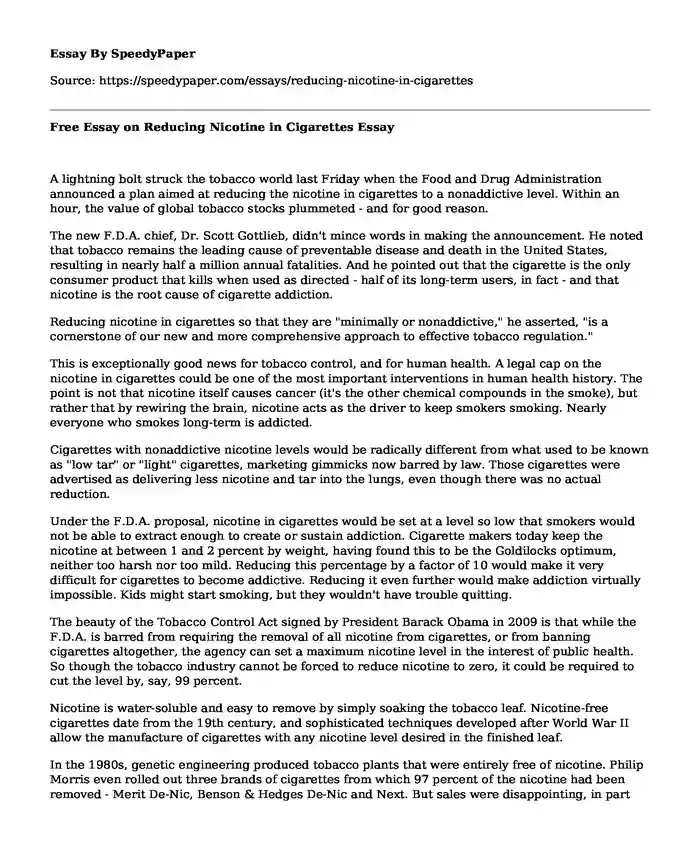
| Type of paper: | Research paper |
| Categories: | Substance abuse |
| Pages: | 4 |
| Wordcount: | 839 words |
A lightning bolt struck the tobacco world last Friday when the Food and Drug Administration announced a plan aimed at reducing the nicotine in cigarettes to a nonaddictive level. Within an hour, the value of global tobacco stocks plummeted - and for good reason.
The new F.D.A. chief, Dr. Scott Gottlieb, didn't mince words in making the announcement. He noted that tobacco remains the leading cause of preventable disease and death in the United States, resulting in nearly half a million annual fatalities. And he pointed out that the cigarette is the only consumer product that kills when used as directed - half of its long-term users, in fact - and that nicotine is the root cause of cigarette addiction.
Reducing nicotine in cigarettes so that they are "minimally or nonaddictive," he asserted, "is a cornerstone of our new and more comprehensive approach to effective tobacco regulation."
This is exceptionally good news for tobacco control, and for human health. A legal cap on the nicotine in cigarettes could be one of the most important interventions in human health history. The point is not that nicotine itself causes cancer (it's the other chemical compounds in the smoke), but rather that by rewiring the brain, nicotine acts as the driver to keep smokers smoking. Nearly everyone who smokes long-term is addicted.
Cigarettes with nonaddictive nicotine levels would be radically different from what used to be known as "low tar" or "light" cigarettes, marketing gimmicks now barred by law. Those cigarettes were advertised as delivering less nicotine and tar into the lungs, even though there was no actual reduction.
Under the F.D.A. proposal, nicotine in cigarettes would be set at a level so low that smokers would not be able to extract enough to create or sustain addiction. Cigarette makers today keep the nicotine at between 1 and 2 percent by weight, having found this to be the Goldilocks optimum, neither too harsh nor too mild. Reducing this percentage by a factor of 10 would make it very difficult for cigarettes to become addictive. Reducing it even further would make addiction virtually impossible. Kids might start smoking, but they wouldn't have trouble quitting.
The beauty of the Tobacco Control Act signed by President Barack Obama in 2009 is that while the F.D.A. is barred from requiring the removal of all nicotine from cigarettes, or from banning cigarettes altogether, the agency can set a maximum nicotine level in the interest of public health. So though the tobacco industry cannot be forced to reduce nicotine to zero, it could be required to cut the level by, say, 99 percent.
Nicotine is water-soluble and easy to remove by simply soaking the tobacco leaf. Nicotine-free cigarettes date from the 19th century, and sophisticated techniques developed after World War II allow the manufacture of cigarettes with any nicotine level desired in the finished leaf.
In the 1980s, genetic engineering produced tobacco plants that were entirely free of nicotine. Philip Morris even rolled out three brands of cigarettes from which 97 percent of the nicotine had been removed - Merit De-Nic, Benson & Hedges De-Nic and Next. But sales were disappointing, in part because high-nicotine cigarettes remained on the market, and the industry's campaign to deny all evidence of harm precluded an advertising campaign highlighting the benefits of these new products.
Of course, we can expect the industry to fight this new proposal, which threatens the historical mainstay of their business. It will claim that lowering the nicotine in cigarettes to such a low level amounts to a de facto ban, which is prohibited by the F.D.A.'s charter. Tobacco companies no doubt will warn of the rise of a bootleg-era black market for high-nicotine cigarettes.
The industry would still be able to sell nicotine in other forms, like e-cigarettes, nicotine orbs, sticks and lozenges, for example, and gums and patches. And people would still be able to buy cigarettes. But the important point is that they would also be able to quit at will. Smoking would return to being a matter of free choice.
Cigarette makers themselves have started to claim they to want to move smokers away from traditional cigarettes to other alternatives, like smoke-free products. Philip Morris has spent over $3 billion on this post-cigarette push, and in Britain the company has been reportedly paying people to persuade people to quit. "We are absolutely serious - one day we want to stop selling cigarettes," a company executive said.
How quickly will the F.D.A. move to establish a nicotine standard? One worrisome sign is that the plan is part of a "multiyear road map." But there is an urgency here that should not be forgotten. Dr. Gottlieb himself warned that if present consumption rates continue into the 2050s, 17 million more Americans will lose their lives to tobacco.
If the industry is serious about what it claims to want, maybe cigarette makers should sit down with the F.D.A. and hammer out a plan to end this catastrophic and entirely preventable epidemic.
Cite this page
Free Essay on Reducing Nicotine in Cigarettes . (2022, Oct 28). Retrieved from https://speedypaper.net/essays/reducing-nicotine-in-cigarettes
Request Removal
If you are the original author of this essay and no longer wish to have it published on the SpeedyPaper website, please click below to request its removal:
- Free Essay on Intercultural Communication Barriers and Solutions Between Nigeria and China
- Terrorism Financing Essay Example
- Free Essay with Analysis of Yes, The Wealthy Can Be Deserving
- Annotated Bibliography Example on Sociological Issues
- Behavior of Markets - Macroeconomics Essay Example
- Free Essay Sample: Health Care Problems - Informed by Evidence-Based Practice (EBP)
- Essay Example Reviewing PR-Related Articles
Popular categories




